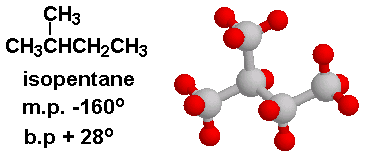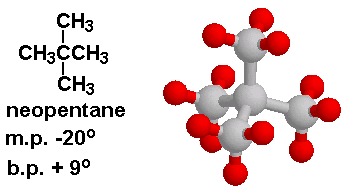
Pentanes
As the number of carbon atoms increases, so does the number of possible isomers. The next member of the alkane series, pentane, C5H12, has three isomers. The five carbons may be arranged in a continuous chain to give n-pentane, with one branch to give isopentane, or with two branches to give neopentane (Fig. 1-19). Each of these pentanes is a well-known organic species, differing slightly in physical and chemical properties from the other two.



Figure 1-19. The structures of the three isomeric pentanes, C5H12
These three isomers furnish another example of the effect of the structure of a molecule on its physical properties. We look first at the melting points. The n-pentane melts higher than isopentane because it can assume a rodlike shape in which adjacent molecules can pack closely together. But neopentane melts more than 100° higher than either of its isomers. A Stuart-Briegleb space filling model of neopentane will show it to be an almost spherical molecule, which can easily pack into an almost perfect crystal. The boiling points of the three isomers are nearly in the opposite order. The long n-pentane molecules fit rather neatly together; they present the greatest opportunity for intermolecular attraction. Consequently, evaporation occurs more slowly than from its branched-chain isomers. The spherical neopentane molecules exert relatively little attraction on each other and so have a low boiling point. As a general rule, the more symmetrical the molecule, the higher its melting point and the lower its boiling point relative to its isomers.
Copyright (c) 1999. All rights reserved.